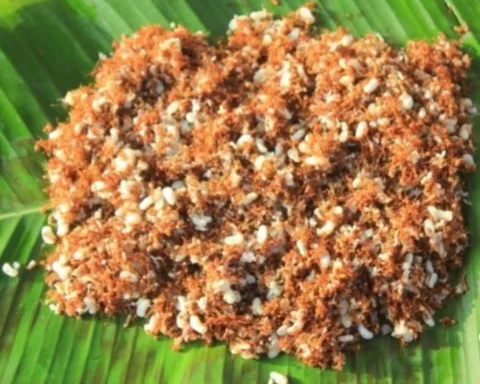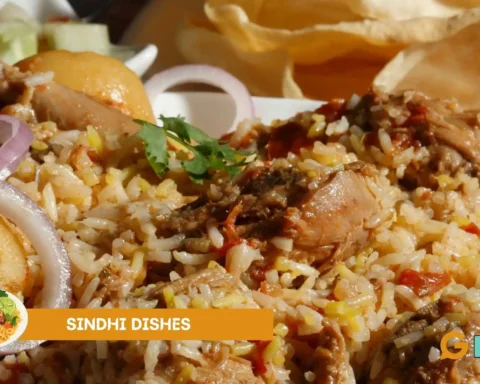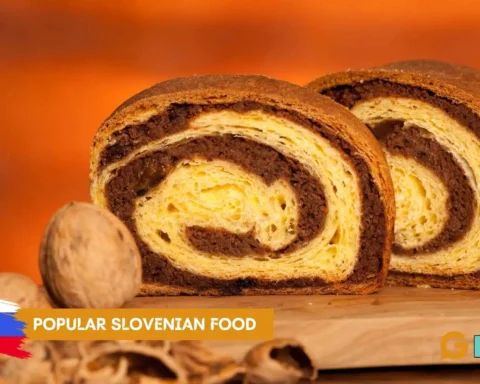Matoke Recipe is a culinary guide aimed at acquainting you with the art of preparing delicious and authentic dishes using plantains, commonly known as "Matoke." This blog offers step-by-step instructions and insights into crafting delicious recipes that feature matoke as the main ingredient.
Whether you're a seasoned cook looking to expand your repertoire or a culinary enthusiast eager to explore new flavours, "Know Matoke Recipe" provides valuable tips and techniques to create mouthwatering dishes that highlight this tropical fruit's versatility and culinary potential. Come, let us explore more about this dish.
Table of Contents
What Is Matoke?
Matoke is commonly called plantains. It is a variety of starchy green bananas, typically larger and firmer than sweet dessert bananas.
Matoke is an unusual dish that is especially popular in countries of East Africa like Uganda, Tanzania, Kenya, and Rwanda, where it is a staple food and a significant part of the local cuisine. It is often cooked and served in various forms, such as boiled, steamed, or fried, and is commonly enjoyed as a side dish or main course. In these regions, Matoke is an essential part of traditional dishes native to East African meals and cultural celebrations.
Are Matoke and Plantain Similar?
Both plantain and Matoke refer to the same fruit. "Plantain" is a more widely used term, while "Matoke" is a specific name for a variety of banana or plantains in certain regions, particularly in countries of East Africa like Uganda, Tanzania, Kenya, and Rwanda. The term "Matoke" is commonly used in these regions to refer to the starchy cooking bananas that are a staple food in their cuisine. So, both terms refer to the same type of fruit, which is a larger, starchy unripe banana often used for cooking rather than eating raw.
Recipe of Matoke Curry
Here's a traditional national dish of East Africa, a delicious family version authentic recipe for "Matoke Curry," a flavorful meal, an aromatic dish made with intensely rich flavour using unripe green cooking bananas and a handful of spices. This African dish is a healthy, staple, and delicious food popular in Uganda, Tanzania, and Kenya.
Ingredients:
- 4-5 green or unripe plantains (Matoke), peeled and chopped into bite sizes pieces
- 1 medium onion, finely chopped
- 1 large fresh medium tomato
- 2 tomatoes, chopped
- 2-3 garlic cloves, minced
- 1-inch piece of ginger, minced
- 1-2 green chillies, chopped (adjust to taste)
- 1 teaspoon cumin seeds or cumin powder
- 1 teaspoon turmeric powder
- 1 teaspoon coriander powder
- 1 teaspoon garam masala
- 1/2 teaspoon red chilli powder (adjust to taste)
- 1/2 teaspoon ground black pepper
- 1/2 teaspoon cayenne pepper
- Salt to taste /lemon(optional)
- 2 tablespoons oil
- Fresh cilantro leaves or a handful of coriander leaves, chopped (for garnish)
- Water or beef stock
Instructions:
Heat some vegetable oil in a large pot or pan over medium heat. Add cumin seeds and let them splutter. Add chopped onions and fresh tomatoes and sauté them on medium heat until they turn translucent and slightly golden for a few minutes. Add minced garlic, ginger, and chopped green chillies. Sauté for another minute until the raw smell disappears. Add turmeric powder, coriander powder, red chilli powder, cayenne pepper, and ground black pepper. Stir well to coat the spices with the onion mixture.
Add chopped tomatoes and cook on medium-high heat until they become soft and start breaking down. Add the chopped Matoke (plantains) chunks and mix well to combine with the spices for a couple of minutes. Pour enough water or beef stock to cover the plantains, or boil them in a pressure cooker. Add salt to taste. Stir, cover the pot, and let it simmer on medium-low heat. Check and stir occasionally, adding water, and cover and cook over low heat until plantains are tender. (this might take around 20-30 minutes). Once the Matoke is cooked and fork tender and attains a chewy texture, add garam masala and mix gently. Taste and season with salt if needed.
Add a bit of water to adjust the consistency. If you prefer a thicker gravy, mash a few pieces of Matoke to help thicken the curry and add a dash of lemon juice. Garnish with freshly chopped cilantro leaves. Serve the Matoke curry hot with rice, chapati (Indian flatbread), or your choice of bread. To bring to the initial texture, add water while reheating.
This Matoke Curry is a delightful combination of flavours and textures, showcasing the natural sweetness of the plantains combined with the aromatic spices. It's a comforting and hearty dish often enjoyed as a main course in East African cuisine.
Matoke Recipe with Bell-pepper Stir Fry
Here's another recipe for "Matoke and Bell Pepper Stir-Fry," a colourful and flavorful dish that combines the natural sweetness of bell peppers with the mildness of Matoke. This recipe is inspired by East African cuisine.
Ingredients:
- 4-5 green or unripe plantains (Matoke), peeled and sliced
- 2 green or red, or yellow bell peppers colour, thinly sliced
- 1 medium onion, thinly sliced
- 2 tomatoes, chopped
- 2 cloves of garlic, minced
- 1 teaspoon cumin seeds
- 1 teaspoon turmeric powder
- 1 teaspoon paprika or red chilli powder
- 1/2 teaspoon of cayenne pepper or green pepper(optional)
- Salt to taste
- 2 tablespoons oil
- Fresh coriander leaves, chopped (for garnish)
- Water
Instructions:
Heat oil in a pan over medium heat. Add cumin seeds and let them splutter. Add sliced onions and sauté until they become soft and slightly caramelized. Add minced garlic and sauté for another minute until fragrant. Add turmeric powder, cayenne pepper (optional), and paprika (red chilli powder). Mix well to coat the onions and garlic with the spices with water.
Add chopped tomatoes, cook until they soften, and create a thick base for 5-7 minutes. Add sliced Matoke and bell peppers to the pan. Stir to combine with the tomato mixture. Pour a splash of cold water, cover the pan, and let the mixture cook on medium heat. Check and stir occasionally, adding water as needed to prevent sticking. Cook until the Matoke slices are tender for 8-10 minutes, and the bell peppers are slightly softened but retain some crunch.
Season with salt to taste and mix well. Garnish with fresh coriander leaves or a dash of cayenne pepper if you like it spicy. Serve the Matoke and Bell Pepper Stir-Fry hot with rice, chapati, or your preferred choice of bread.
This dish offers a delightful contrast between the mild Matoke and the vibrant flavours of bell peppers. The spices and vegetables create a harmonious balance of taste and texture, making it a satisfying and colourful addition to your meal.
What are the Nutrients in Matoke?
Matoke, or plantains, is a nutrient-rich fruit offering a spectrum of essential nutritional elements. This versatile fruit is notably high in dietary fibre, promoting digestive health and satiety. It boasts significant vitamins such as vitamin A for immunity and vision and vitamin C as an antioxidant for skin health and immune support. With a substantial presence of vitamin B6, Matoke contributes to brain health and metabolism. The fruit is also a notable source of potassium, aiding in blood pressure regulation and muscle function.
Furthermore, its magnesium content supports nerve function, bone health, and energy production. Additionally, Matoke contains B vitamins like folate and niacin, both vital for cellular health. Notably low in fat and sodium, Matoke is a heart-friendly choice, and its unripe form offers resistant starch beneficial for gut health. While its antioxidant content reduces oxidative stress to give healthy skin, Matoke remains a wholesome addition to a balanced diet, providing an array of nutrients that contribute to overall well-being.
Why is Matoke Healthy?
Matoke, or plantains, offer several health benefits due to their nutritional content:
Rich in Dietary Fiber: Matoke is a good source of dietary fibre, which aids in digestion, helps maintain healthy bowel movements, and can contribute to better weight management.
Complex Carbohydrates: It contains complex carbohydrates that release sustained energy, preventing rapid spikes and crashes in blood sugar levels.
Vitamins and Minerals: Matoke contains essential vitamins like vitamins A, C, and B6. It also provides minerals such as potassium, which supports heart health and helps regulate blood pressure.
Lower Sugar Content: Compared to sweet bananas, Matoke is a low-calorie food, making it a suitable option for those aiming to manage their sugar intake.
Gluten-Free: Matoke is naturally gluten-free, making it a suitable dietary option for individuals with gluten sensitivities or celiac disease.
Satiety: The combination of dietary fibre and complex carbohydrates in Matoke can help promote a feeling of fullness, aiding in appetite control.
Nutrient Diversity: Incorporating various foods into the diet is essential for overall health. Matoke adds diversity to meals, providing unique flavours and nutrients.
It's worth noting that while Matoke offers health benefits, how it's prepared can impact its nutritional value. Boiling, steaming, or baking are healthier cooking methods compared to deep-frying, which can add excess calories and unhealthy fats. As with any food, moderation and balanced consumption are vital to reaping its benefits.
How is Matoke Prepared for Cooking?
Remember that the way Matoke is prepared depends on its ripeness. Ripe plantains are sweeter and work well in fried or baked dishes, while unripe plantains are starchier and often used in boiled or savoury preparations. The choice of spices, herbs, and other ingredients can vary based on the dish's personal touch, regional preferences, and desired flavour profile.
Boiled Matoke: Matoke is often peeled and boiled in a few cups of water in a pressure cooker until tender. It can be sliced or left whole and is commonly served with a peanut butter sauce, stew, or gravy. The boiled Matoke is also used to make vegetable stock that can absorb the flavours of the accompanying dish.
Fried Matoke: Ripe Matoke can be sliced and fried until golden and crispy. This preparation results in a sweet and savoury dish enjoyed as a snack or side dish with tomato sauce.
Matoke Chips: Like fried Matoke, unripe green plantains can be sliced thinly and deep-fried to make plantain chips, a popular snack enjoyed with peanut sauce.
Matoke Mash: Matoke can be boiled and mashed, similar to mashed potatoes. It's seasoned with spices, herbs, and even coconut milk to enhance the flavour.
Matoke Curry: Matoke can be included in various curry dishes, contributing texture and flavour to the preparation.
Matoke Fritters: Matoke can be grated and combined with other ingredients to make fried fritters until crispy.
Matoke Soup: Matoke can be added to soups to provide a unique flavour and textural element.
What does Matoke taste like?
Matoke, or plantains, have a distinct taste that varies depending on their ripeness. Unripe or green bananas are starchy and have a mild, slightly earthy flavour. They are not as sweet as ripe bananas and have a firm texture when cooked. They are often used in savoury dishes and take on the flavours of the spices and ingredients they are cooked with.
As green bananas ripen and turn yellow or black, their flavour becomes sweeter and their texture softer. Ripe plantains can have a subtle banana-like sweetness with hints of tropical fruit, and they are commonly used in sweet and savoury dishes.
Conclusion
In the captivating realm of gastronomy, the enchanting Matoke recipe reigns supreme. As the aromatic Matoke Curry exemplifies, vibrant green bananas gracefully harmonize with a tapestry of spices and ingredients, crafting a symphony of savoury allure and delicate sweetness. The artful fusion of cooking techniques and seasonings elevates Matoke's essence, rendering it a versatile muse for an array of delectable creations.
FAQs
Why is matoke important in culture?
Matoke is important in African culture as a staple food that symbolizes unity, heritage, and tradition, fosters social gatherings, and supports livelihoods while providing nutritional value.
What percentage of Matoke is water?
Matoke typically contains around 65-70% water. The high water content contributes to its unique texture and makes them suitable for various cooking methods. The exact percentage can vary depending on factors such as the ripeness of the bananas and specific varieties.
How do to keep Matoke from ripening?
To keep Matoke from ripening rapidly, separate bunches to prevent ethylene exposure. Store them in a cool, well-ventilated area, using perforated plastic bags for humidity control. Avoid refrigeration, as it hampers their ripening process. For more extended storage, consider freezing the unripe Matoke.
Can Matoke be eaten raw?
No, Matoke is not consumed raw. It needs to be cooked due to its starchy nature and dense texture. Cooking transforms it into palatable and flavorful food.










